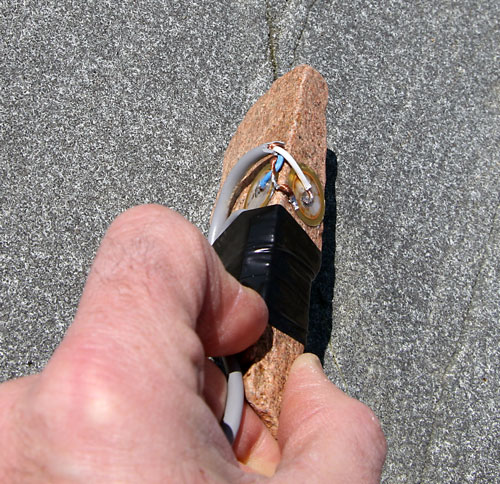What are the oldest phonograph recordings in North America? Here's a hint: they predate Thomas Edison's 1877 recording of "Mary Had a Little Lamb"[1] by at least 12,000 years.

Playing the rock (here, a basaltic intrusion into the granitic basement rock).
During the Wisconsin Glacial Episode,[2] rock fragments carried along by the mile-thick ice sheet carved countless miles of linear grooves, or striae, into the hard bedrock. When this monuntain of ice finally retreated about 12,000 years ago, it left behind a storehouse of planetary knowledge encoded in the bedrock grooves that are now visible all across the northern hemisphere.
How do we listen to these recordings? And what messages do they contain?
The first step, of course, is to build a pickup. The diamond- or sapphire-tipped needles of a vinyl phonograph player are much too fine for this purpose. But a small hand-held piece of granite works well. Simply attach a pair of piezoelectric transducers, arranged orthogonally so as to capture the independent vertical and lateral components of the rock's motion and — voilà — you have a glacial stereo pickup. All that's left is to plug the pickup into a sound recorder and drag the pickup along a groove at a steady pace...
This is not a new idea. In 1919 the poet Rainer Maria Rilke noticed the similarity of the coronal suture in the human skull to the wiggly lines in the early wax cylinder sound recordings. In his essay "Primal Sound" he speculated on the possibility of converting these lines into sound:
Sound artists have begun to explore Rilke's idea to uncover Nature's hidden sound recordings. Bartholomäus Traubeck[3] used the circular patterns in tree rings to generate sounds through a process of sonification: the translation of a non-acoustic signal into musical notes. Although Traubeck's sonification is one step removed from the direct translation into sound of the "close wavy lines" of Nature, it represents an important step in expanding our imagination to embrace the sounds invisibly embedded in the world around us.
A Universe of unheard sound and music surrounds us, waiting to be uncovered.

Closeup of the stereo pickup, made of local pink granite.
,